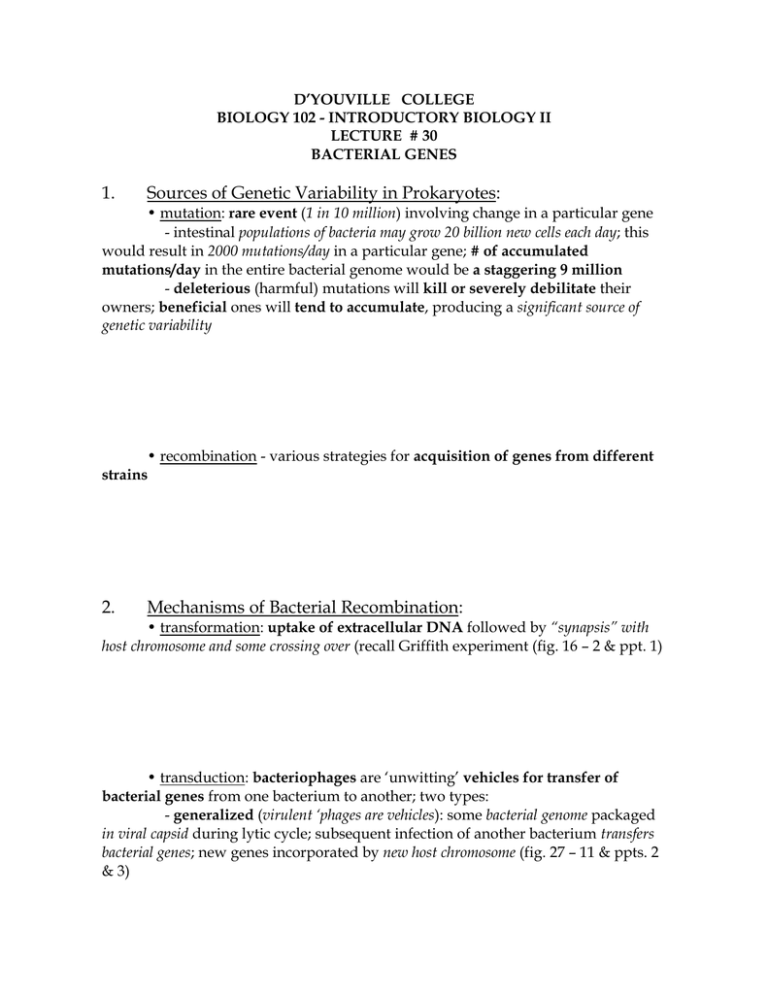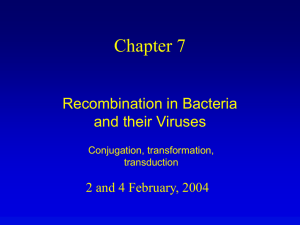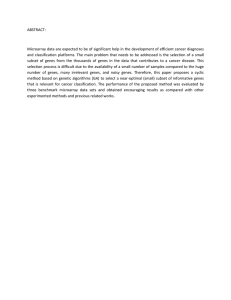30. Bacteria.doc
advertisement

D’YOUVILLE COLLEGE BIOLOGY 102 - INTRODUCTORY BIOLOGY II LECTURE # 30 BACTERIAL GENES 1. Sources of Genetic Variability in Prokaryotes: • mutation: rare event (1 in 10 million) involving change in a particular gene - intestinal populations of bacteria may grow 20 billion new cells each day; this would result in 2000 mutations/day in a particular gene; # of accumulated mutations/day in the entire bacterial genome would be a staggering 9 million - deleterious (harmful) mutations will kill or severely debilitate their owners; beneficial ones will tend to accumulate, producing a significant source of genetic variability • recombination - various strategies for acquisition of genes from different strains 2. Mechanisms of Bacterial Recombination: • transformation: uptake of extracellular DNA followed by “synapsis” with host chromosome and some crossing over (recall Griffith experiment (fig. 16 – 2 & ppt. 1) • transduction: bacteriophages are ‘unwitting’ vehicles for transfer of bacterial genes from one bacterium to another; two types: - generalized (virulent ‘phages are vehicles): some bacterial genome packaged in viral capsid during lytic cycle; subsequent infection of another bacterium transfers bacterial genes; new genes incorporated by new host chromosome (fig. 27 – 11 & ppts. 2 & 3) Bio 102 lec. 30 - p. 2 Bio 102 lec. 30 - p. 3 - specialized (temperate ‘phages are vehicles): some adjacent bacterial genes accompany prophage excision as a temperate phage resumes lytic cycle; genes transfer to new host upon infection; powerful vehicle for genetic recombination (ppts. 2 & 3) • conjugation: transfer of genes between different mating types (discussed with plasmids below) 3. Plasmids: “accessory” chromosomes first found in bacteria • sex factor (F-plasmid): facilitates conjugation (sex pilus formation (fig. 27 – 12 & ppt. 4) facilitates connection & gene transfer between donor & recipient) - occurrence of conjugation was suspected from experiments showing recombinant strain in cultures of mixture of two different nutrient-requiring strains (ppt. 5) - F+ mating type (donor) has sex factor; F- mating type (recipient) lacks sex factor; F- converted to F+ following conjugation; transfer of sex factor (F plasmid) causes conversion (fig. 27 – 13a & ppts. 6) - Hfr strains are donors with integrated (episomic) sex factor; conjugate more frequently, transfer chromosomal genes + incomplete sex factor); gene recombination occurs in recipient, e.g. met-/bio- strain x thr-/leu- strain: recombinant strain grows on minimal medium (fig. 27 – 13b & ppt. 7) Bio 102 lec. 30 - p. 4 Bio 102 lec. 30 - p. 5 • R-plasmids carry genes for antibiotic resistance; some have genes for sex pili and can transfer like F-plasmids 4. Transposons: are genes or groups of genes that can move to a new location on a plasmid or within the main genome (transposition) • insertion sequence codes for transposase (enzyme that catalyzes transposition)(ppts. 8 & 9) • composite transposon: one or more chromosomal genes sandwiched between two insertion sequences; transferred from chromosome to plasmid (or vice versa) or from one plasmid to another; mechanism for concentration of antibiotic resistance genes in R- plasmid (ppt. 10)






